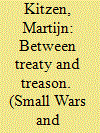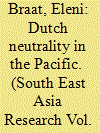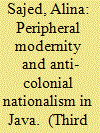|
|
|
Sort Order |
|
|
|
Items / Page
|
|
|
|
|
|
|
| Srl | Item |
| 1 |
ID:
109956


|
|
|
|
|
| Publication |
2012.
|
| Summary/Abstract |
Recent counterinsurgency experiences in Iraq and Afghanistan have demonstrated that the local operating environment often is dominated by indigenous power-holders. As counterinsurgents seek to establish control over the local population, collaboration with these agents has become an essential aspect of contemporary counterinsurgency. Although the practice of constructing collaborative relationships with indigenous power-holders might be perceived as unconventional by today's counterinsurgents, the approach itself goes back to the colonial era in which modern counterinsurgency has its roots. This article explores the dynamics, benefits, and dangers of collaborative relationships with indigenous power-holders by analysing an infamous episode in Dutch colonial history, the case of the collaboration between Dutch colonial authorities and warlord Teuku Uma during the Aceh War (1873-1913). This relationship ended in disaster for the Dutch as Uma departed their side at the moment he had become their pivotal asset in the local political landscape. The article explains that the Dutch succeeded to co-opt Uma, but failed to control him as they lacked the will and means to do so. Furthermore this case study provides an insight in the way the Dutch colonial authorities dealt with the complex process of intelligence-gathering in a fragmented indigenous society.
|
|
|
|
|
|
|
|
|
|
|
|
|
|
|
|
| 2 |
ID:
103508


|
|
|
|
|
| Publication |
2011.
|
| Summary/Abstract |
The international disarmament debate of the 1920s provided an important opportunity for the Netherlands to raise the international profile of its colonial interests. This paper examines how Dutch participants in the disarmament debate combined the long-lived Dutch principle of neutrality with the different geopolitical situation of the Dutch East Indies. It shows that (1) Dutch delegates did not strictly interpret and apply the principle of neutrality to their colony in the Pacific. This seems contrary to (2) the Dutch perception that the position in Europe was almost identical to the situation in the Pacific. The little attention paid to these different interests in the Netherlands and the Dutch East Indies arguably developed from (3) a surprising naivety and provincialism concerning the geopolitical position of the Dutch East Indies. These three related conclusions illustrate the unfortunate composition of the delegations to the disarmament negotiations and the ignorance with which the Foreign Ministry intervened in colonial issues, arguably also indicating that Dutch colonial external relations and defence policy were ill-defined and not effectively adapted to the Pacific context.
|
|
|
|
|
|
|
|
|
|
|
|
|
|
|
|
| 3 |
ID:
188716


|
|
|
|
|
| Summary/Abstract |
This article examines the first decade of Pasar Gambir as an annual week-long festival held in the Dutch East Indies in conjunction with Queen Wilhelmina's birthday. As a study of colonial spectacles, it seeks to address the dearth of scholarly literature that analyses how the Western exhibitionary complex functioned in a colonised environment. In producing Pasar Gambir, the Dutch colonisers did not adopt this exhibitionary complex in its entirety. As such, Pasar Gambir assumed the hybridised form of a jaarmarkt-tentoonstelling (fair-cum-exhibition) imbued with market-like characteristics. This reality distinguished Pasar Gambir from its metropolitan equivalents by involving the colonised not only as objectified exhibits on display, but also as active consumers and participants of the spectacle. Ultimately, this article argues that the hybridity of Pasar Gambir undercut Dutch efforts to use it as a vehicle that illustrated and vindicated their claims of benevolence and racial supremacy. Through the Malay language press’ appropriation of the spectacle to underscore the moral superiority of the colonised and the Indies Chinese’ successful boycott of Pasar Gambir in 1925, colonised communities contested the empire-building messages that the Dutch sought to convey through Pasar Gambir and inscribed their own nationalist readings and interpretations of the annual jaarmarkt-tentoonstelling instead.
|
|
|
|
|
|
|
|
|
|
|
|
|
|
|
|
| 4 |
ID:
151509


|
|
|
|
|
| Summary/Abstract |
This analysis investigates the limits of colonial modernity in the 20th century Dutch East Indies at a time that coincided with the building of the Indonesian national project. I am interested in the constitution of the national teleology as an inexorable socio-political project, deploying specific racial and gendered economies. As a locus of investigation I choose the literary narratives of two celebrated Indonesian intellectuals (and participants in the anti-colonial struggle), Pramoedya’s Buru Quartet and Mangunwijaya’s Durga/Umayi. Were the impulses of anti-colonial resistance intrinsically national in their orientation? Through what erasures and re-appropriations has the nationalism/modernity paradigm become the medium of decolonisation?
|
|
|
|
|
|
|
|
|
|
|
|
|
|
|
|
| 5 |
ID:
118898


|
|
|
|
|
| Publication |
2012.
|
| Summary/Abstract |
Everyday technologies of the nineteenth century-mass-produced items that were small, sturdy, and affordable-transformed the daily lives of working people in Asian colonies. There is already a large literature on colonial technology transfer and a specialist literature on the sewing-machine, which draws on Singer archives, production figures, sales techniques, and advertising to establish uptake by households from North America to the Philippines, India, China, and Egypt. Still, documentation of how and why imported objects such as the sewing-machine were appropriated is difficult to find because, unlike elites, ordinary people left few records of their own. Here a visual archive is investigated to complement existing studies. Photographs and early moving pictures from the former Dutch East Indies show that ordinary Indonesians sought and appropriated imported goods such as the sewing-machine. The colonial camera's visual record of sewing-machine operators displaces attention from the more impersonal trade and productivity statistics. It brings the silent user into the history of technological uptake and allows us to consider the repercussions across a wide social band and period. Indigenous tailors and seamstresses expanded their own work options. Through the Singer they fitted out and launched their compatriots into modern jobs and lifestyles in the Dutch colony. The sewing-machine changed habits, manners, and expectations; machine operators influenced senses of propriety, fashion, and status. Appropriation of mundane technology demonstrates that modernization was not only a process trickling down to the masses from Westernizing elites; it also bubbled up from below.
|
|
|
|
|
|
|
|
|
|
|
|
|
|
|
|
|
|
|
|
|